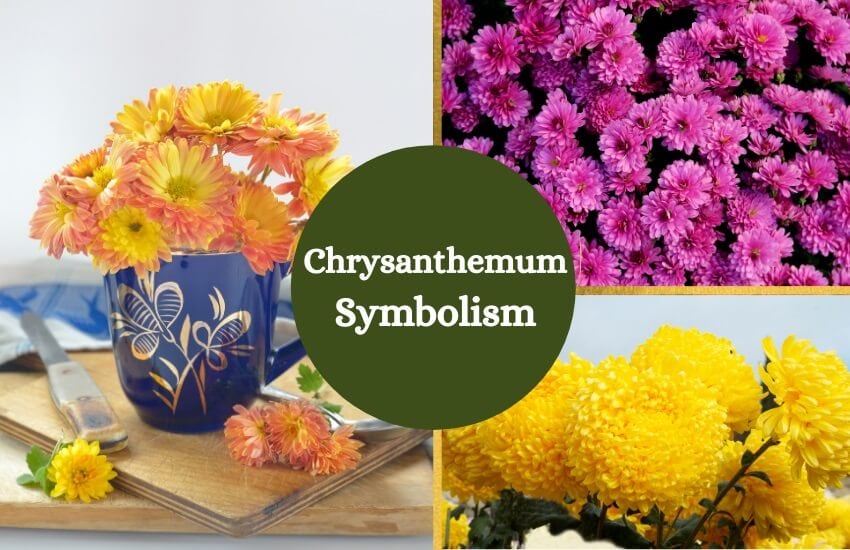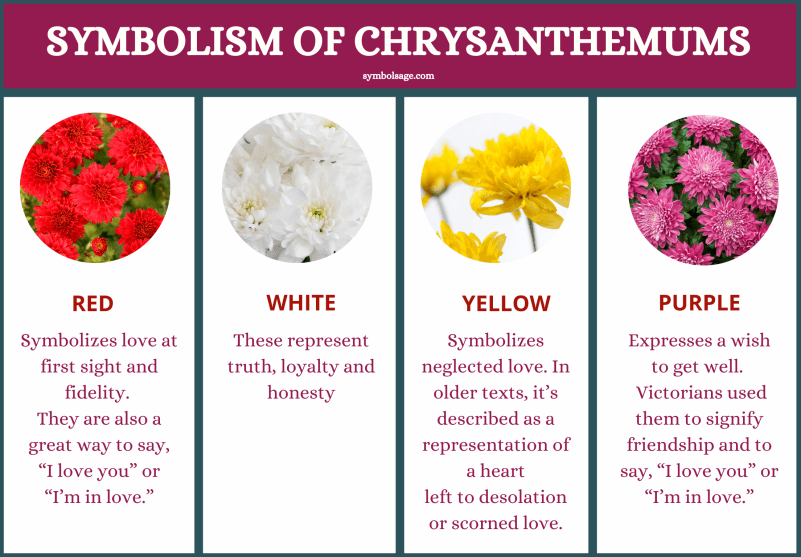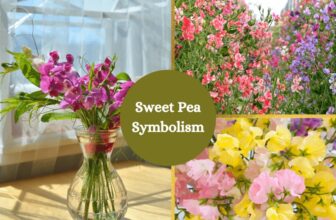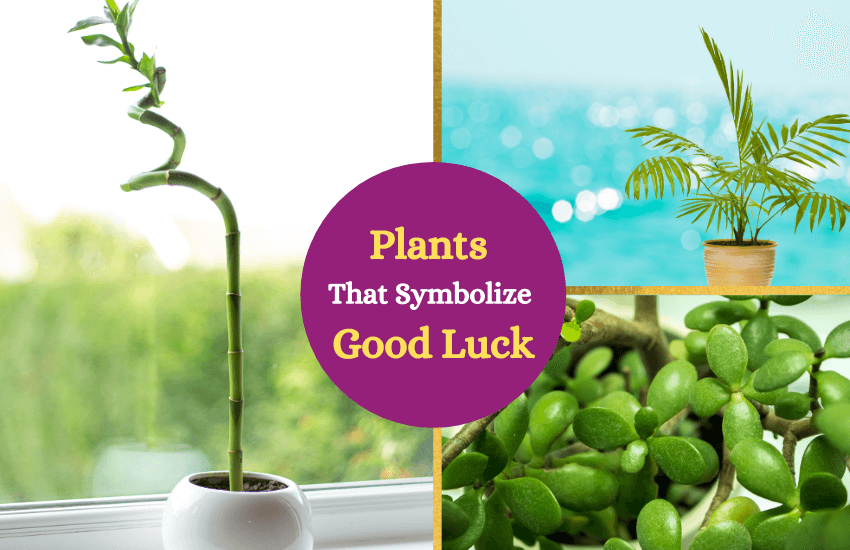
Table of Contents
Adored for its lush petals in bright seasonal shades, chrysanthemums come in many varieties and shapes, adding beauty to gardens. Let’s take a look at the long, rich history of the bloom and its significance today.
About the Chrysanthemum Flower
Native to Asia and northeastern Europe, Chrysanthemum is the genus of flowers in the Asteraceae family. Do you know its name comes from the Greek terms chrysos that means gold, and anthos that translates as flower? As the name suggests, its original color was gold, but it has since been bred in many shapes and colors, such as red, white, pink, orange, purple, lavender and so on.
Also called mums, these blooms have hundreds of tiny flowers, also called florets. When it comes to varieties, there are many including pompons, anemones, buttons and even spider-like flowers. While the pompons have colorful globes of petals, the spider varieties have long, spiky petals, as if they’re an exploding firework. On the other hand, the button mums have rounded shapes and resemble a button.
These flowers are usually planted in early spring when the weather is temperate. However, they’re quite hardy and once established, can be planted at any time, except in freezing wintry temperatures.
- Interesting Fact: Did you know chrysanthemums are related to sunflowers and dahlias? However, its family is quite controversial since many of the varieties that once belonged to the Chrysanthemum genus are now part of different genera. Some of them are the Paris daisy, feverfew and corn marigold, just to name a few.
Meaning and Symbolism of the Chrysanthemum
Chrysanthemums have gained several symbolic meanings, but their specific color meaning varies greatly. Here are some of them:
- A Symbol of Happiness – Sometimes called the Flower of Happiness, the bloom is often used in Feng Shui to bring happiness into the home.
- Optimism and Hope – These blooms represent cheerfulness in adversity, which makes life more meaningful. No wonder, it’s also sometimes called the Flower of Life or the Flower of the East.
- Abundance and Wealth – During Imperial China, chrysanthemums were only grown by the aristocrats and the nobility and were forbidden to the common people. Nowadays, the Chinese culture regarded them as a symbol of luck and long life.
- In some contexts, it can also represent unconscious beauty, especially the Chrysanthemum morifolium commonly known as the Red Daisy.
- Red Chrysanthemums symbolizes love at first sight and fidelity. These red blooms are also a great way to say, “I love you” or “I’m in love.”
- White chrysanthemums represent truth, loyalty and honesty.
- Yellow chrysanthemums symbolize neglected love. In older texts, it’s described as a representation of a heart left to desolation or scorned love.
- Purple chrysanthemums can express a wish to get well. It’s also thought that Victorians used them to signify friendship.

However, chrysanthemums can mean different things in different cultures and regions. Here are some of them:
- In Europe, the bloom is associated with death and grief, as well as love for the departed. In fact, it’s commonly used as a memorial flower placed on graves. Christianity is the predominant religion in Europe which likely contributed to the association of the flower, since the Crown Daisy or the Chrysanthemum coronarium, is said to have adorned Jesus’ body when he was put in the tomb.
- In Italy and Malta, the flower is regarded as bad luck.
- In the U.S. chrysanthemums symbolize cheerful and positive feelings and are often used in homecoming events.
- In many Asian countries, white chrysanthemums are associated with grief and loss too, particularly in Korea, Japan and China.
- In Japan, these blooms were used as the emblem of the Imperial family. Also, they had a Supreme Order of the Chrysanthemum, which was awarded by the emperor to the military. Nowadays, they’re associated with a festival of happiness or the National Chrysanthemum Day.
- In China, it’s regarded as the emblem of youth. The city of Chu-hsien was named after the bloom, which means the Chrysanthemum City.
Uses of the Chrysanthemum Flower
There are different types of chrysanthemums and certain varieties have been used in rituals and medicine for centuries.
In Superstitions
Many believe that the flower will promote mental health, release anger, evoke forgiveness and provide protection. In the ancient times, it was used as an amulet to protect someone from the wrath of the gods.
In some cultures, it’s even thought that chrysanthemums have magical powers and is most powerful during the summer solstice. Some varieties of chrysanthemums are planted around the homes, used in floral baths, and even burned as an incense, in hopes of attracting peace and luck.
Industrial Uses
Chrysanthemums contain natural pesticides, called pyrethrins, which are often used to control pests, as well as flies, mosquitoes, ants and moths.
In Literature and Paintings
Chrysanthemums have inspired several works of art, including the 1937 The Chrysanthemums by John Steinbeck. The flower played a central role in the novel highlight of the story, where the main character has a deep interest in chrysanthemums.
In Chinese art, the Four Gentlemen, also known as the Four Noble Ones, features the bloom along with bamboo, orchid and plum. They’re often the highlight of various Chinese watercolor paintings too.
In Medicine
Disclaimer
In China, some varieties of the flower have been used as a tonic for depression, as well as an anti-inflammatory. In other cultures, chrysanthemums are used to relieve pain from insect bites, headaches, sore throats and sore eyes. They’re even planted in the gardens and displayed indoors for their air-purifying properties.
In Gastronomy
In Chinese cuisine, certain varieties of chrysanthemum are incorporated into salads, soups and dishes, and the petals are often featured in teas and beverages.
The Chrysanthemum Flower Today
Nowadays, these blooms are valued in landscapes, giving that four-season look in your yard. In some regions, large shrubs of chrysanthemums have been shaped into geometric forms, which give a stunning display throughout the seasons. They’re also great for decorating your patios, porches and decks, as well as front yard and window boxes.
Chrysanthemums are one of the most long-lasting blooms that can be chosen. They’ll look beautiful and fresh in vase arrangements lasting for up to two weeks or more. In fact, it’s the highlight of ikebana flower arrangements during the Chrysanthemum Festival in Japan.
For fall weddings, they’re a beautiful choice for bouquets. If you’re a hip and modern bride, white spider mums will add some personality to your style and make things a bit unexpected. These blooms also make a beautiful display when arranged in color groupings in table decorations.
When to Give Chrysanthemum Flowers
If you’re thinking what to give to a November baby on their birthday, chrysanthemums are the November’s birth flower. It’s also the official 13th wedding anniversary bloom. In many cultures, these flowers are associated with happiness, but it’s still best to include a note that expresses the bloom’s significance since it has some negative associations.
Due to its name, chrysanthemums or mums are an ideal gift for Mother’s Day too. Since it also represents the truth, it’s a great choice for an apology bouquet. From engagements to anniversaries and other special occasions, these blooms will surely express your sincere sentiments.
In Brief
As you have seen, there’s a chrysanthemum flower for every taste. With its multitude of varieties and symbolisms, you’ll not only spruce up your landscape, but also bring warmth, color and happiness to your garden and floral arrangements.





